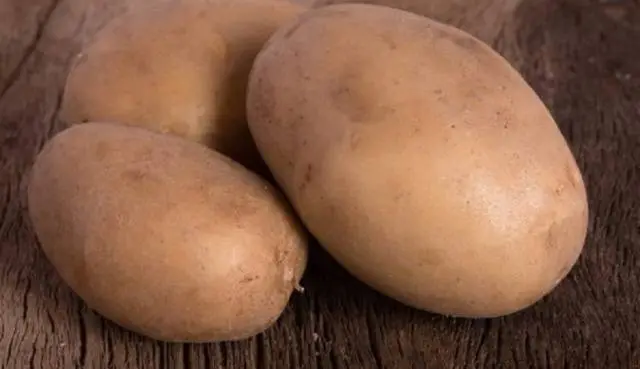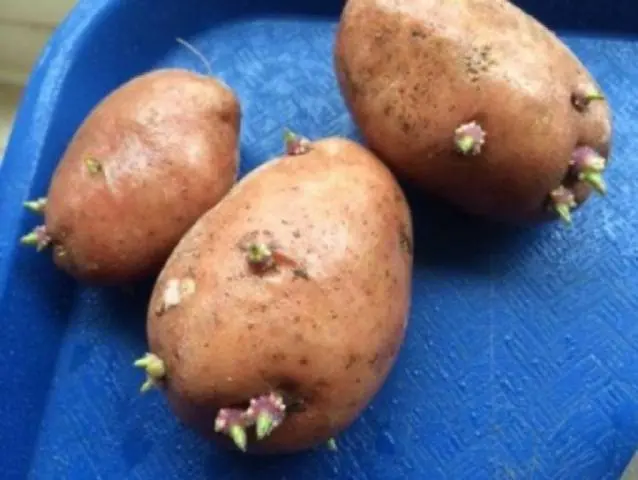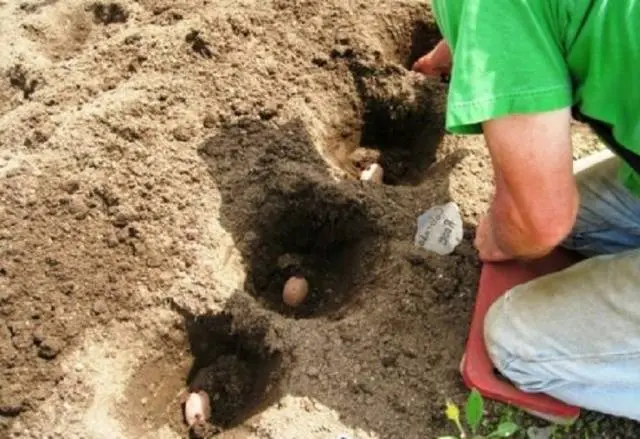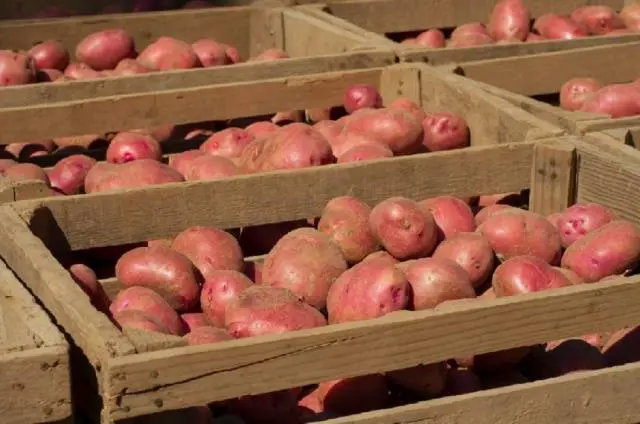Contents
Potato “Vector” is a table variety with good consumer qualities. Due to its adaptability to soil and climate, the species is suitable for cultivation in areas of the middle lane and the North-West region. In addition to universal use, it has a lot of useful qualities, which will be discussed in the article. For completeness of the description, photos of the Vector potato variety and reviews of those who grew it will be used.
Variety description
Acquaintance with potatoes of the “Vector” variety should begin with a description of the characteristics of the vegetable and reviews of gardeners. This is the most significant information for those who wish to plant a variety on their site. The consumer qualities of the Vector potato are quite high, so its cultivation is very profitable.
Potato “Vector” belongs to the varieties of Belarusian selection. It has good resistance to diseases and the ability to bear fruit in regions with different climates and soil composition. According to the description, sod-podzolic and marsh-peat soil is best suited for planting potatoes “Vector”, but on other soils the variety also gives a good harvest. Received “Vector” by crossing the species “Glow” and “1977-78”.
The description of the potato variety “Vector” should begin with the parameters of the bush. The plant is medium-sized, semi-erect. The leaves are small, dark green in color, the flowers are purple. One plant has 10-15 inflorescences. The variety does not respond well to thickening. Despite the average size of the bush, you should clearly follow the pattern when planting the Vector potato.
According to the ripening period, the variety of potatoes “Vector” belongs to the middle late. Tuber formation ends 85-110 days after planting.
Productivity is an important characteristic when describing the Vector potato. Up to 14-15 quality tubers are formed on one plant. The average yield in the fields is 45 t/ha, and under favorable conditions it increases to 70 t/ha.
The tubers are medium in size, pink in color, oval in shape. The mass of one is 120 g. The eyes on the roots are shallow, in a small amount. The peel is brown, dense.

The taste qualities of the “Vector” potato are highly valued. On a five-point system, they are evaluated at 4,6 points. The flesh of the tubers is firm, but has good juiciness, does not darken during heat treatment. This allows you to use the table variety for various purposes in cooking. Despite the fact that the potatoes “Vector” boil a little when cooked, the tubers are great for making chips.
The next worthy characteristic is that the Vector potato is well stored. Waste during the winter is no more than 5%.
The variety shows high resistance to damage by late blight, viral infections, common scab, alternariosis, the causative agent of cancer. However, it can hurt with a striped and wrinkled mosaic, twisting of the leaves. Among pests, the golden cyst nematode is the most dangerous.
Advantages and disadvantages
It is better to group the main characteristics of the “Vector” potato variety using a table. This will increase visibility and make it easier to perceive information.
Advantages | Disadvantages |
High yield | Late ripening |
Heat and drought tolerance | High percentage of starch in tubers |
Great taste | Average boilability when cooking |
Application versatility |
|
High level of keeping quality and transportability. |
|
Resistance to a number of diseases |
|
High adaptability to soil composition and growing conditions |
|
Suitability for mechanical harvesting and processing |
|
The list of advantages of the variety is much larger than the list of disadvantages, so the variety of potatoes “Vector” is very popular among vegetable lovers. To get a high-quality crop in large volumes, you need to properly plant.
Planting varieties
Proper planting of potatoes “Vector” includes several stages. Each has its own nuances and subtleties. The final result – the yield – depends on the thoroughness of each step. The most important are:
- Selection of planting material and its preparation for planting.
- Boarding times.
- Soil preparation.
- Planting potatoes “Vector” on the site.
Let’s consider each stage in more detail.
Selection and preparation of planting material
The most important moment. The further development of the potato bush depends on the health, quality and even size of the planting tubers. Potatoes “Vector” for planting are selected according to several criteria – size, appearance and shape. It is best to plant tubers of the same size. It is optimal to choose not too small or large potatoes. According to reviews, the best result is obtained when planting tubers the size of chicken eggs. The even shape of the seeds is welcome, without sharp curvatures and creases. Each specimen should not show signs of pest or disease damage. In the description of the potato variety “Vector” and the reviews, it is noted that there are a small number of eyes on the tubers. But for reproduction it is good to leave potatoes with the most buds.
The photo shows an example of high-quality seed material:

Such a technique will significantly reduce germination.
There is one more nuance. When the variety “Vector” is purchased only for propagation, then all available tubers are used.
To speed up the process of seed germination, pre-sowing preparation is carried out for tubers. The main stage is germination. Potatoes “Vector” are placed in boxes or on another flat dry surface in one layer. After 7-10 days, sprouts will appear on them. The seeds of “Vector” germinate even faster if they are placed in wet sawdust, periodically watered. 2-3 days before immersion in the ground, the tubers of “Vector” are heated in the sun.
Terms of planting
According to the description of the variety and the reviews of gardeners, it is best to plant Vector potatoes in May. At the beginning or middle of the month – this date is chosen depending on the weather conditions and the characteristics of the growing region. It is important to consider that the soil temperature before planting should be at least 10 ° C at a depth of 10 cm. Before the scheduled planting time, the tubers and the site should already be prepared. We have already described how the planting material is prepared, now we will focus on preparing the site for the Vector potato.
Soil preparation
The site is selected with good lighting and moisture permeability of the soil. If the water stagnates, then the culture will simply rot.
Potato varieties “Vector” refers to unpretentious species. But if you carry out competent preparation of the site, then the yield increases significantly. At the same time, one must not forget that the variety prefers loamy soils with a neutral or slightly acidic reaction. It grows well on black soil and sandy loam. To improve conditions for the development of plants, the site is prepared in the fall. When digging, organic fertilizers are added per 1 sq. m of area as follows:
- 3-4 kg of humus;
- 100 g of wood ash.
At the time of planting, additionally add to each hole:
- double superphosphate – 15 g;
- potassium sulfate – 12 g;
- urea – 10 g.
The planting process
The site is cleared of plant debris, weeds and ridges are marked. Digging holes according to the markup. The depth of the landing hole directly depends on the composition of the soil. On clay it is 5 cm, on sand – 10 cm.
The distance between the bushes is kept in the range of 35-40 cm. The aisles are left about 70 cm. The tubers of the “Vector” are placed in the holes with sprouts up.

Cover with soil and level the ground with a rake.
Bush care
In the first 2-3 weeks, it is very important to provide conditions for the growth of the aerial part of the potatoes. Therefore, the earth is weeded, gently loosened and moistened. Before the appearance of flowers, the culture does not need regular watering, but after the start of flowering, it is given enough attention.
Variety “Vector” is resistant to drought, but you should not create extreme conditions for the bushes. It is better to moisten the plantings as needed. Calculate the total volume of water according to the needs of one plant. For one bush you need to spend 2 – 2,5 liters of water. During the growing season, the variety “Vector” needs to be provided with 4 full-fledged irrigation.
Top dressing. Nutrition must be made after the first hilling. You will need to dilute 1 tbsp. a spoonful of urea in a 10-liter bucket and pour over each Vector bush with a solution in a volume of 0.5 liters. Top dressing is applied after loosening. If the potato is grown on fertilized soil, then it will not often be necessary to feed it. With an average nutritional value of the soil, the feeding scheme looks like this:
Stage | Deadlines | dosage |
№ 1 | Before flowering | 1 st. a spoonful of urea per bucket (10 l) of water |
№ 2 | At the time of budding | For a bucket of water 1 tbsp. spoon of potassium sulfate |
№ 3 | During the flowering period of potatoes | For 10 liters of water 1 tbsp. double spoon of superphosphate |
Pests and diseases
When growing potatoes of the “Vector” variety, it is necessary to take measures against the appearance of fungal infections – Alternaria, late blight of leaves and common scab. To these diseases, “Vector” does not have complete resistance.
To avoid illness will help:
- careful selection of seeds;
- compliance with the planting pattern so as not to thicken the plants;
- compliance with crop rotation on the ridges;
- preventive spraying against fungal diseases.
The most famous potato pest is the Colorado potato beetle. It has to be fought with insecticides and manual collection of beetles. But parasites such as wireworms, slugs or bears can cause no less damage to the crop. Traps are prepared against them and insecticides are also used, guided by the instructions for the drug.
Crop storage
Potato variety “Vector” is famous for keeping quality. But, so that he does not lose this characteristic, preparatory measures are taken:
- dry dug tubers on a dry, flat surface;
- potatoes are carefully stacked, pre-selecting the highest quality ones.
The room is prepared in advance, providing the potatoes with the necessary temperature, storage humidity and the possibility of ventilation.










